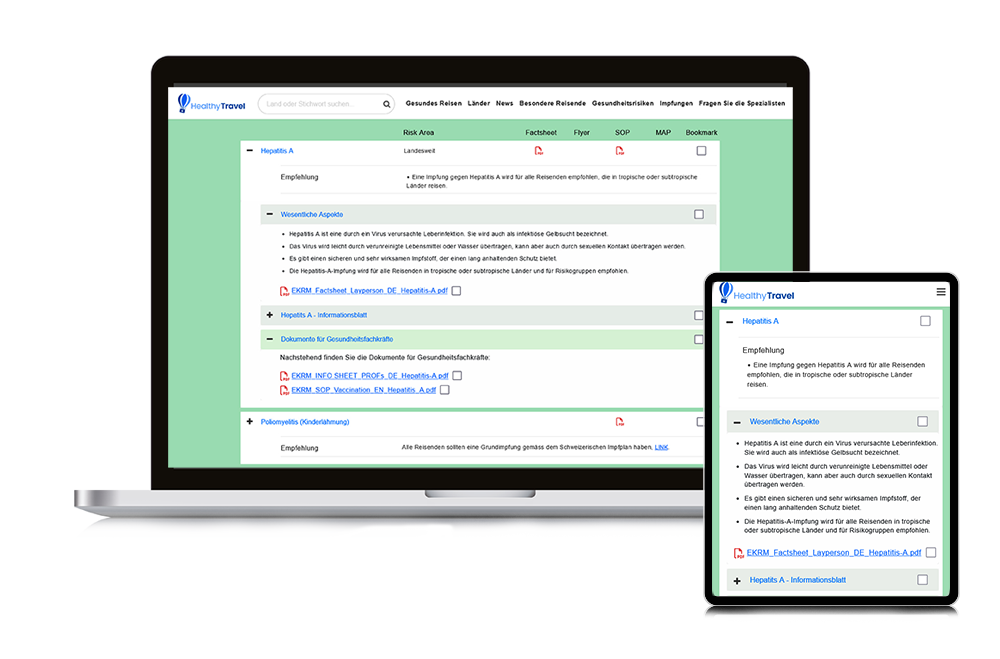Our Purpose
Healthy and safe travel - our main aim is that you can enjoy your trip in good health and that it becomes an unforgettable experience! We are at your assistance, whether with information for optimal travel preparation, vaccination recommendations, maps, tips in case of illness and much more! All information can be compiled and saved individually. The site is under construction and will be continuously expanded with additional content and updates.
Our Experts

Latest News
Get informed about the latest travel medicine news in your destination
Africa: Multi - country mpox outbreak due to monkeypox virus clade I and clade II – update 15 June 2025
Clade Ib mpox virus (MPXV) (emerging clade): Available evidence suggests exclusive human-to-human contact transmission for this virus clade. Within the last 6 weeks, outbreaks continue to be reported in DRC (2’706 clade Ia/b), Uganda (914), Burundi (121), Kenya (66), Rwanda (1), Zambia (16), Congo (12, clade Ia, Ib, and IIa/b), Tanzania (15), Malawi (33), Ethiopia (18), and South Sudan. Travel-associated cases have been reported in several countries, including recently in China and Australia. For more information, see LINK.
Clade Ia MPXV is endemic in the following countries: DRC, Central African Republic, Republic of Congo, Cameroun, Sudan. Travel-related cases have been reported in China and Ireland. Epidemiological data and phylogenetic analyses still suggest that many outbreaks of clade Ia MPXV result from zoonotic spillover with secondary human-to-human transmission. However, there is emerging evidence of increasing sustained human-to-human transmission of one lineage of clade Ia MPXV from 2024, mainly through sexual contact, in Kinshasa.
Clade IIa MPXV is endemic in West Africa with rare zoonotic spillover to humans. Since 2024, increased number of cases in adults and children reported from Côte d’Ivoire, Ghana, Guinea, and Liberia in different locations, including their capital cities. Genomic sequencing analyses suggest the occurrence of repeated zoonotic spillover events followed by limited secondary human-to-human transmission.
Clade IIb MPXV (emerging clade): Available evidence suggests exclusive human-to-human contact transmission for this virus clade. Clade IIb sub-lineage B.1 (global epidemic in 2022) is still circulating worldwide at low level. Clade IIb sub-lineages A.x are circulating in Africa and the WHO Eastern Mediterranean Region. Within the last 6 weeks, outbreaks of clade IIb sub-lineages A.2 with community transmission have been reported from West Africa with Sierra Leone particularly affected (2’698 cases). In addition, cases have been reported from Liberia (100), Ghana (80 cases), Nigeria (17), Togo (18), Côte d’Ivoire (9), Guinea (1).
Weekly trends in Africa, see also LINK.
Mpox affected countries in Africa (source dashboard WHO):
Namibia: Rabies in marine mammal (seal)
Namibia has reported its first confirmed case of rabies in a Cape fur seal at Walvis Bay Lagoon, marking the first known instance of rabies in marine mammals in the country. The seal was observed to display signs consistent with rabies on 13 June 2025 and later died. This follows a similar case reported in South Africa in June 2024. Authorities are urging the public to report abnormal seal behavior and to avoid contact with wildlife. While rabies is endemic in Namibia, typically spread through domestic dog bites, its appearance in marine species is rare and raises new concerns for wildlife and public health.
South America: Adjustment of yellow fever risk areas due to increasing transmission
Following the significant increase in yellow fever cases in 2025 (see EpiNews 13 June 2025), the Swiss Expert Committee for Travel Medicine has adapted the risk areas where yellow fever vaccination is recommended. Notably, in addition to previously identified areas, the revised recommendations now include the following newly designated risk areas:
All countries:
- expansion of risk for stays up to 2’500m elevation in all countries
- vaccination may be considered for regions marked in green on the CDC map
Peru: Machu Picchu and all Inca trails
Colombia: islands of San Andrés and Providencia, stays in all national parcs (new entry requirement!)
Colombia: Yellow fever outbreak 2024 -2025 – epidemiological update and new requirements
Between 2024 and 2025, Colombia reported 107 confirmed cases and 46 deaths (CFR 43%), with Tolima experiencing the majority of cases. The yellow fever virus (YFV) has been confirmed in 55 non-human primates, indicating ongoing transmission risks.
In response to the rise in yellow fever cases, the country has introduced new vaccination requirements:
- anyone traveling by land or water within Colombian territory must carry a yellow fever vaccination card or certificate. This measure applies to everyone and covers all types of transport, including cars, buses, and boats.
- Visitors to enter any Natural National Parks in Colombia (enforced at entry gates)
Portugal: Hepatitis A outbreak
A total of 504 confirmed cases of hepatitis A have been identified between January and 31 May 2025 in the country. Of these, 122 are associated with transmission through sexual contact. The outbreak has primarily affected men aged 18 to 44, especially among men who have sex with men (MSM).
In addition, a second outbreak was identified in the regions of Algarve, Alentejo, and the Lisbon and Tagus Valley region, with transmission associated with poor health conditions, which has particularly affected the pediatric population.
Slovakia: Fatal amoebic menigoencephalitis case
According to media, an 11-year-old boy in Slovakia died from primary amoebic meningoencephalitis, marking the country’s first known case.
Authorities suspect he may have contracted the infection during a swimming course at the Vadaš Thermal Resort in Štúrovo earlier this month (June 2025). The resort is currently closed as a precaution, pending the results of the investigation.
News media report that this is the first confirmed case in Slovakia, while eighteen cases have been reported in the neighboring Czech Republic.
UK: Fatal case of rabies in a returning traveller from Morocco
In mid of June 2025, a 59-year-old woman from Barnsley, UK, died from rabies after having been scratched by a puppy in Morocco in February 2025.
No human cases of rabies acquired in the UK from animals other than bats have been reported since 1902.
Mexiko: Local transmitted malaria cases in Oaxaca
In Oaxaca, an increase in autochthonous malaria cases was detected, rising from 3 in 2023 to 11 in 2024, in addition to 88 imported cases. Nationally, an increase in cases was observed, with 576 in 2024, representing a 92.6% increase compared to 2023. San Pedro Tapanatepec, Oaxaca, is a municipality with recurrent local transmission.
Portugal: EuroPride events 2025 - joint public health advice*
The EuroPride 2025 will take place from 14 to 22 June 2025 in Lisbon, Portugal. The event is expected to draw around 200’000 people, with more than 60% travelling from abroad.
The European Centre for Disease Prevention and Control (ECDC), the World Health Organization Regional Office for Europe (WHO/Europe), and Portugal’s Direção-Geral da Saúde (DGS) have together issued health advice for people attending the events, see LINK.
Before Travel
HealthyTravel Pro
HealthyTravel Pro for medical travel recommendations and consultations
- Content written by Swiss Expert Committee of Travel Medicine
- Recommended for professionals
- Updated on a weekly base
- Access to SOP
- Detailed maps

Updates of recommendations
Find out about the latest content updates on the websiteSouth America: Adjustment of yellow fever risk areas
The recommendations for yellow fever vaccination have been updated for South America.
Yellow fever recommendation - update
The yellow fever recommendations have been updated for Bolivia, Columbia, Ecuador, Paraguay, Peru, Trinidad and Tobago and Venzuela.
Recommendation mpox outbreak - update
The recommendations for mpox have been updated on 15th June 2025.
Qdenga vaccines Checklist - update
The checklist for Qdenga vaccines has been updated.
Malaria risk areas - update
The risk areas and country maps for malaria have been updated.
Entry requirements for yellow fever - update
The entry requirements for yellow fever have been updated for Uganda, Costa Rica, Benin, Cameroon, Côte d'Ivoire, Equador, Ghana, Nigeria, Singapore and South Sudan.
Yellow Fever Country List
The 'Yellow fever country list (vaccination recommendations and countries’ entry requirements) has been updated and is available on PRO Version -> yellow fever -> documents for professionals
Polio – updated WHO temporary recommendations
The country pages have been updated to reflect the updated WHO temporary polio recommendations.
Archive


